Area Studies TESTS The World of English 1.



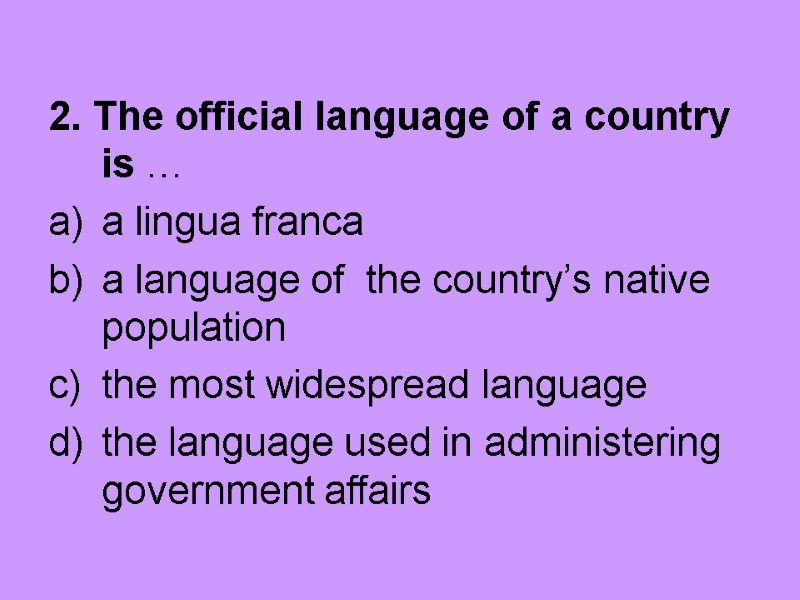





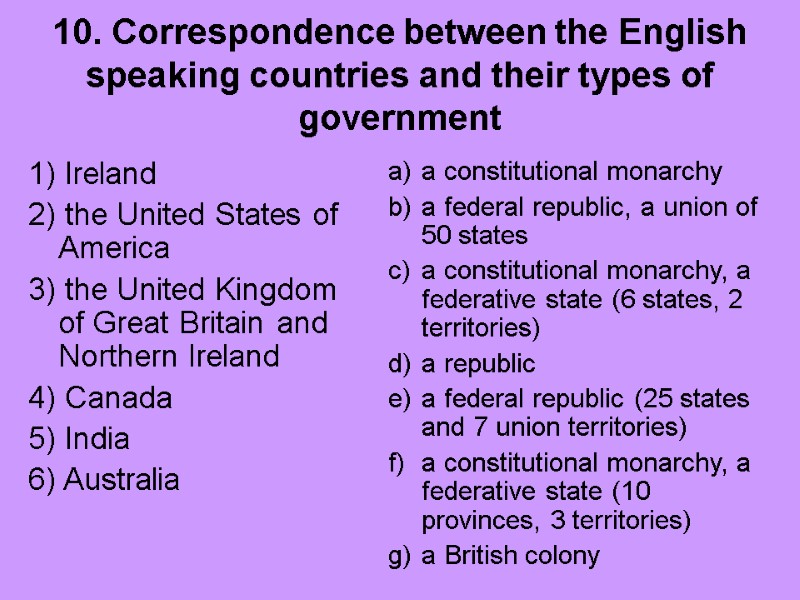

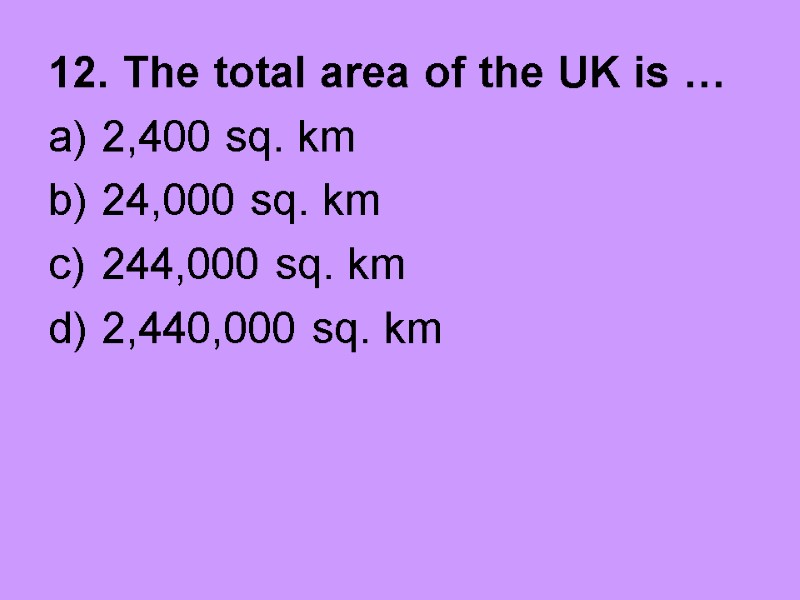



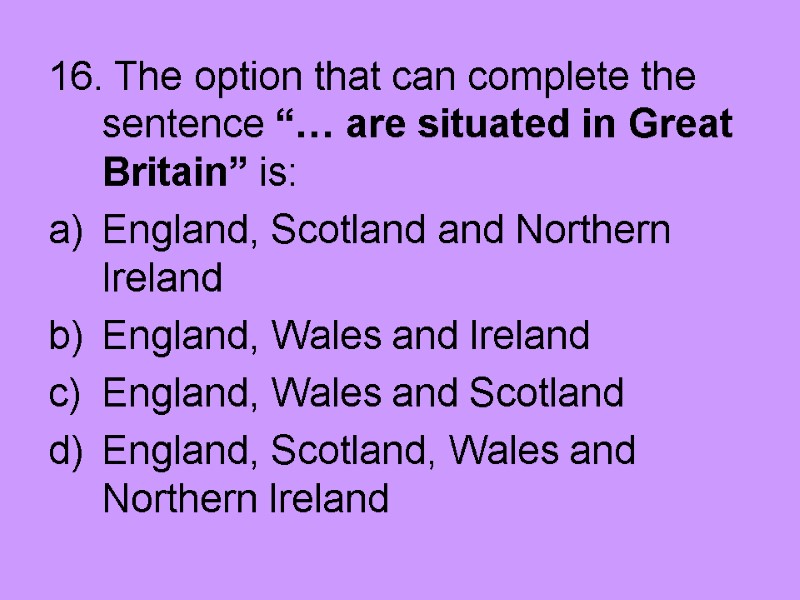









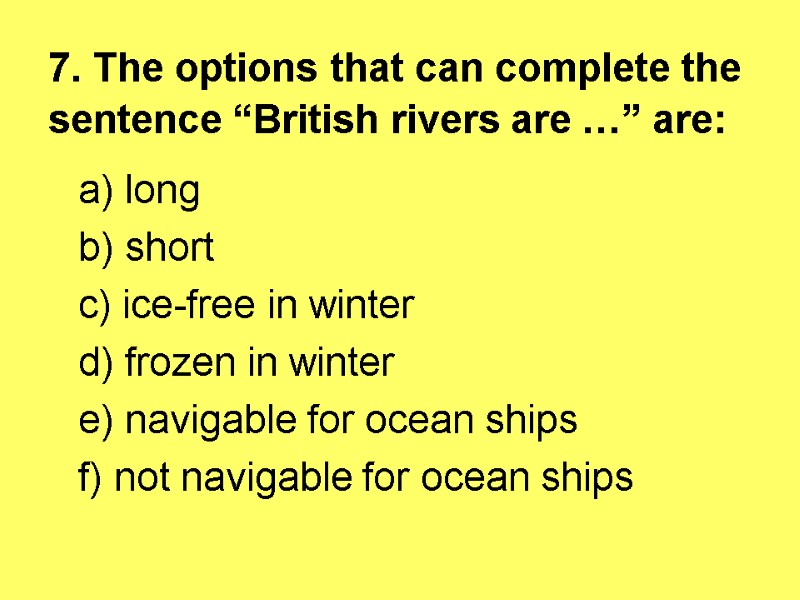


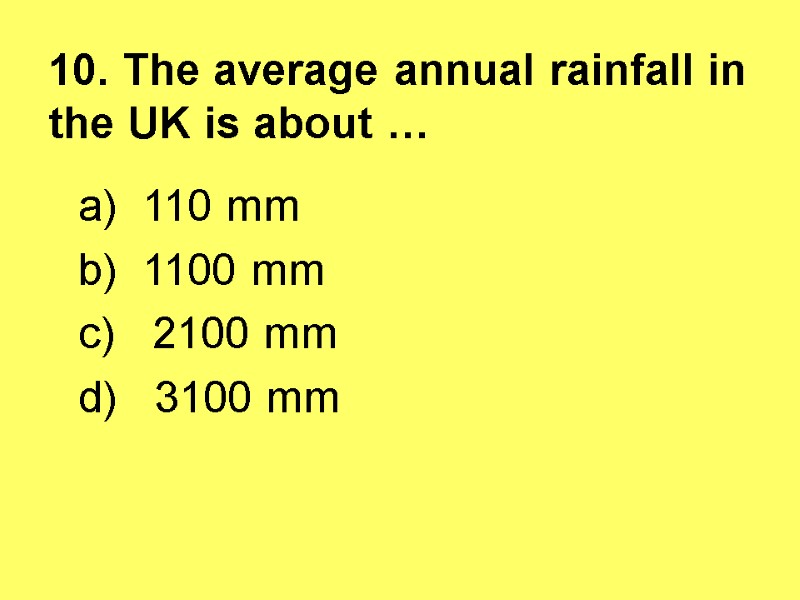


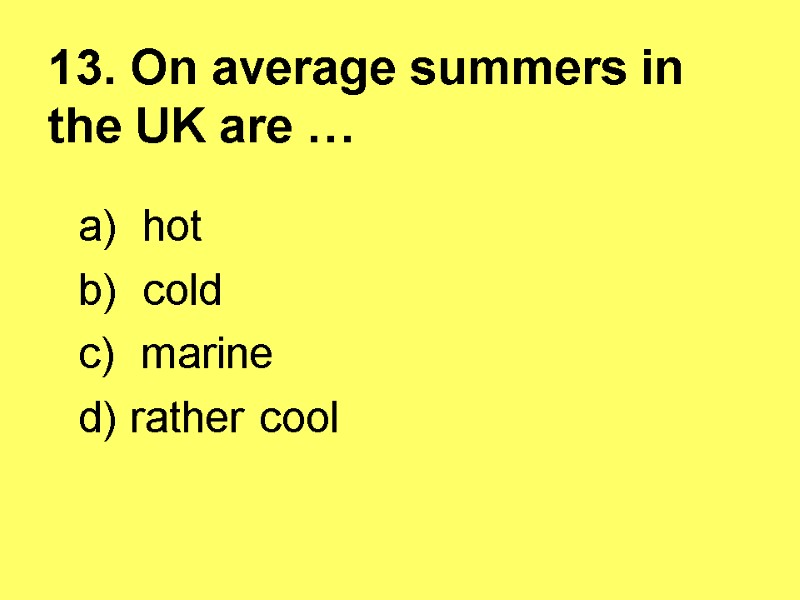










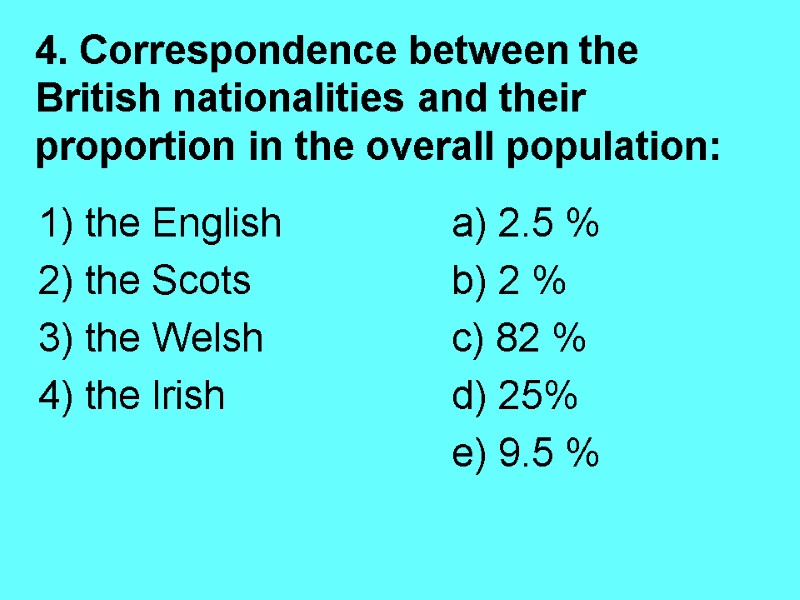











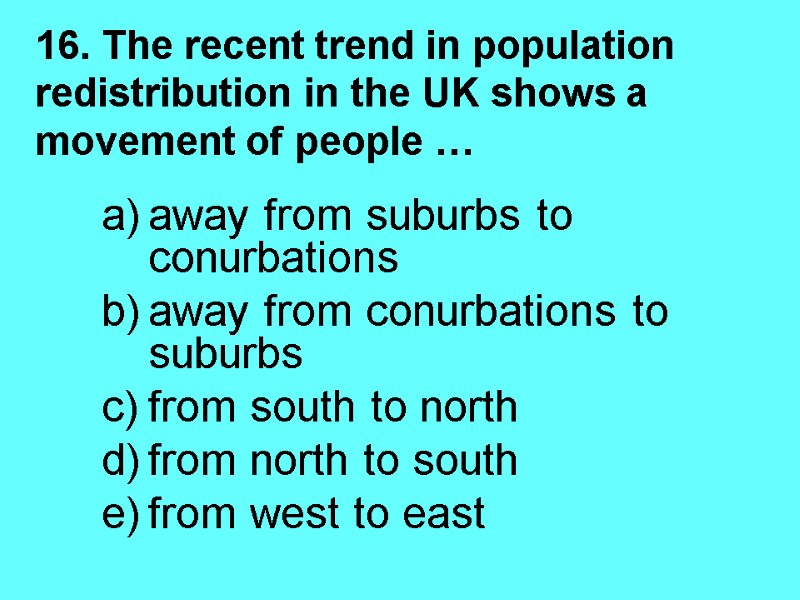
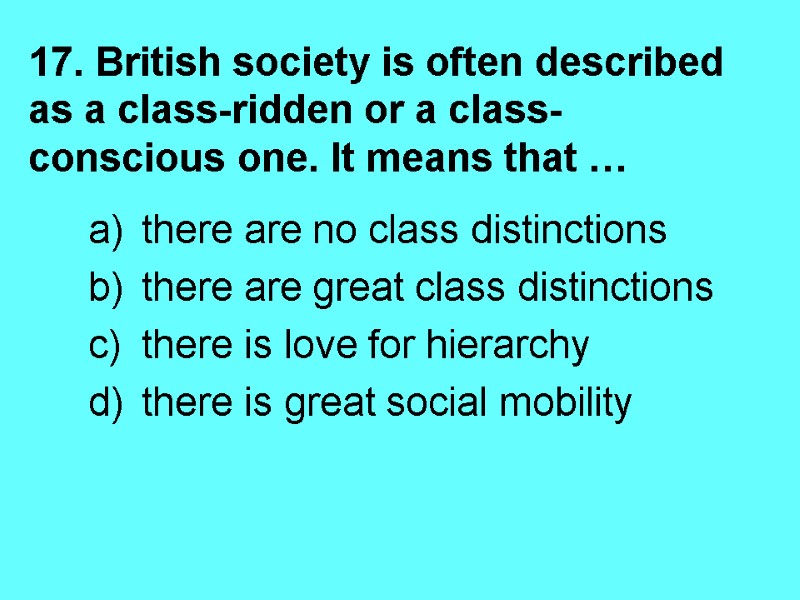







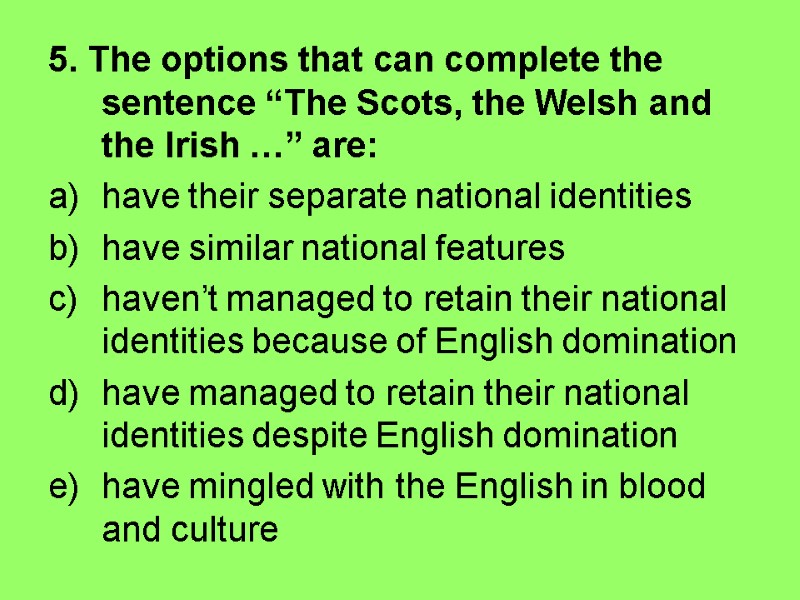









13086-uk._tests.ppt
- Количество слайдов: 72
 Area Studies TESTS
Area Studies TESTS
 The World of English 1. English is a mother tongue of about … people in the world. 350 thousand 35 million 350 million 3 billion
The World of English 1. English is a mother tongue of about … people in the world. 350 thousand 35 million 350 million 3 billion
 2. The official language of a country is … a lingua franca a language of the country’s native population the most widespread language the language used in administering government affairs
2. The official language of a country is … a lingua franca a language of the country’s native population the most widespread language the language used in administering government affairs
 3. The language used by the greatest number of native speakers in the world is _______________. 4. The number of European English speaking countries is _______
3. The language used by the greatest number of native speakers in the world is _______________. 4. The number of European English speaking countries is _______
 5. The group that only contains English speaking countries in Europe is … Ireland, Iceland, the United Kingdom Ireland, Gibraltar, Malta Great Britain, Switzerland, Ireland Malta, Monaco, the United Kingdom
5. The group that only contains English speaking countries in Europe is … Ireland, Iceland, the United Kingdom Ireland, Gibraltar, Malta Great Britain, Switzerland, Ireland Malta, Monaco, the United Kingdom
 6. The option that can complete the sentence “There are … English speaking countries in Asia.” is: 9 19 29 39
6. The option that can complete the sentence “There are … English speaking countries in Asia.” is: 9 19 29 39
 7. The group that contains only English speaking countries in Asia is … Vietnam, India, Nepal Iran, Malaysia, Afghanistan India, Pakistan, Singapore India, Iraq, Laos
7. The group that contains only English speaking countries in Asia is … Vietnam, India, Nepal Iran, Malaysia, Afghanistan India, Pakistan, Singapore India, Iraq, Laos
 8. The Commonwealth developed from … the UK the British Empire the USA the United Nations 9. The official name of Australia is ________
8. The Commonwealth developed from … the UK the British Empire the USA the United Nations 9. The official name of Australia is ________
 10. Correspondence between the English speaking countries and their types of government 1) Ireland 2) the United States of America 3) the United Kingdom of Great Britain and Northern Ireland 4) Canada 5) India 6) Australia a constitutional monarchy a federal republic, a union of 50 states a constitutional monarchy, a federative state (6 states, 2 territories) a republic a federal republic (25 states and 7 union territories) a constitutional monarchy, a federative state (10 provinces, 3 territories) a British colony
10. Correspondence between the English speaking countries and their types of government 1) Ireland 2) the United States of America 3) the United Kingdom of Great Britain and Northern Ireland 4) Canada 5) India 6) Australia a constitutional monarchy a federal republic, a union of 50 states a constitutional monarchy, a federative state (6 states, 2 territories) a republic a federal republic (25 states and 7 union territories) a constitutional monarchy, a federative state (10 provinces, 3 territories) a British colony
 The UK. Location 11. Geographically Great Britain is … a country an island a group of islands a continent
The UK. Location 11. Geographically Great Britain is … a country an island a group of islands a continent
 12. The total area of the UK is … 2,400 sq. km 24,000 sq. km 244,000 sq. km 2,440,000 sq. km
12. The total area of the UK is … 2,400 sq. km 24,000 sq. km 244,000 sq. km 2,440,000 sq. km
 13. The option that can complete the sentence “The UK claims the … place in the world as to its size” is: 17th 37th 57th 75th
13. The option that can complete the sentence “The UK claims the … place in the world as to its size” is: 17th 37th 57th 75th
 14. The option that can complete the sentence “The British Isles consist of … islands” is: two large about 40 about 400 about 4000
14. The option that can complete the sentence “The British Isles consist of … islands” is: two large about 40 about 400 about 4000
 15. Great Britain is the … largest island in the world biggest island in Europe and the 7th largest in the world 2nd largest island in Europe 75th largest island in the world
15. Great Britain is the … largest island in the world biggest island in Europe and the 7th largest in the world 2nd largest island in Europe 75th largest island in the world
 16. The option that can complete the sentence “… are situated in Great Britain” is: England, Scotland and Northern Ireland England, Wales and Ireland England, Wales and Scotland England, Scotland, Wales and Northern Ireland
16. The option that can complete the sentence “… are situated in Great Britain” is: England, Scotland and Northern Ireland England, Wales and Ireland England, Wales and Scotland England, Scotland, Wales and Northern Ireland
 17. The name of the second largest island within the British Isles is _____ 18. The straits separating the UK from the European continent are: the North Channel the Strait of Dover St. George’s Channel the English Channel
17. The name of the second largest island within the British Isles is _____ 18. The straits separating the UK from the European continent are: the North Channel the Strait of Dover St. George’s Channel the English Channel
 19. The sea separating Great Britain and Ireland is the ____________ Sea
19. The sea separating Great Britain and Ireland is the ____________ Sea
 20. Correspondence between the parts of the UK and their local division England Scotland Northern Ireland districts provinces counties regions and island areas
20. Correspondence between the parts of the UK and their local division England Scotland Northern Ireland districts provinces counties regions and island areas
 II. UK. Relief. Climate. Inland Waters. Flora. Fauna 1. British mountains are situated in … a) southern Great Britain and Northern Ireland b) eastern and southeastern Great Britain c) northern, western and central Great Britain d) northern Wales and eastern England
II. UK. Relief. Climate. Inland Waters. Flora. Fauna 1. British mountains are situated in … a) southern Great Britain and Northern Ireland b) eastern and southeastern Great Britain c) northern, western and central Great Britain d) northern Wales and eastern England
 2. Correspondence between the mountains and parts of the UK they are situated in: 1) the Cambrian Mountains 2) the Pennine Chain 3) the Cheviot Hills 4) the Highlands 5) the Southern Uplands a) northern England b) Northern Ireland c) Wales d) central England e) southern Scotland f) northwestern Scotland
2. Correspondence between the mountains and parts of the UK they are situated in: 1) the Cambrian Mountains 2) the Pennine Chain 3) the Cheviot Hills 4) the Highlands 5) the Southern Uplands a) northern England b) Northern Ireland c) Wales d) central England e) southern Scotland f) northwestern Scotland
 3) The altitude of Ben Nevis is … a) 343 m b) 1343 m c) 2343 m d) 3243 m
3) The altitude of Ben Nevis is … a) 343 m b) 1343 m c) 2343 m d) 3243 m
 4. The relief of Scotland includes: a) the Pennines b) the Highlands c) the Cambrian Mountains d) the Southern Uplands e) the Lowlands
4. The relief of Scotland includes: a) the Pennines b) the Highlands c) the Cambrian Mountains d) the Southern Uplands e) the Lowlands
 5. Most British rivers flow … a) northward b) southward c) westward d) eastward
5. Most British rivers flow … a) northward b) southward c) westward d) eastward
 6. The option that can complete the sentence “… is lowland” is: a) the southeastern part of England b) the northwestern part of Scotland c) the northwestern part of England d) the western part of Wales
6. The option that can complete the sentence “… is lowland” is: a) the southeastern part of England b) the northwestern part of Scotland c) the northwestern part of England d) the western part of Wales
 7. The options that can complete the sentence “British rivers are …” are: a) long b) short c) ice-free in winter d) frozen in winter e) navigable for ocean ships f) not navigable for ocean ships
7. The options that can complete the sentence “British rivers are …” are: a) long b) short c) ice-free in winter d) frozen in winter e) navigable for ocean ships f) not navigable for ocean ships
 8. Attributes, which can be applied to the description of the British climate, are: a) dry e) cold b) humid f) mild c) arid g) continental d) hot h) marine
8. Attributes, which can be applied to the description of the British climate, are: a) dry e) cold b) humid f) mild c) arid g) continental d) hot h) marine
 9. The type of climate the UK enjoys is … a) temperate continental b) temperate marine c) Mediterranean d) subarctic
9. The type of climate the UK enjoys is … a) temperate continental b) temperate marine c) Mediterranean d) subarctic
 10. The average annual rainfall in the UK is about … a) 110 mm b) 1100 mm c) 2100 mm d) 3100 mm
10. The average annual rainfall in the UK is about … a) 110 mm b) 1100 mm c) 2100 mm d) 3100 mm
 11. The average January temperature in England is … a) minus 4 degrees C b) 0 degrees C c) 4 degrees C d) 14 degrees C
11. The average January temperature in England is … a) minus 4 degrees C b) 0 degrees C c) 4 degrees C d) 14 degrees C
 12. On average winters in the UK are … a) cold b) hot c) mild d) snowy
12. On average winters in the UK are … a) cold b) hot c) mild d) snowy
 13. On average summers in the UK are … a) hot b) cold c) marine d) rather cool
13. On average summers in the UK are … a) hot b) cold c) marine d) rather cool
 14. The result of the rain-shadow effect in the UK is that … a) the eastern parts of the country are wetter than the western parts b) the western parts of the country are wetter than the eastern parts c) there are deserts in the southeast d) the rainfall is evenly distributed throughout the country
14. The result of the rain-shadow effect in the UK is that … a) the eastern parts of the country are wetter than the western parts b) the western parts of the country are wetter than the eastern parts c) there are deserts in the southeast d) the rainfall is evenly distributed throughout the country
 15. Correspondence between British rivers and lakes and their description: 1) the Severn 2) Lough Neagh 3) Loch Ness 4) the Avon a) the river associated with William Shakespeare b) the place associated with William Wordsworth c) the longest British river d) the largest British lake a lake in Scotland
15. Correspondence between British rivers and lakes and their description: 1) the Severn 2) Lough Neagh 3) Loch Ness 4) the Avon a) the river associated with William Shakespeare b) the place associated with William Wordsworth c) the longest British river d) the largest British lake a lake in Scotland
 16. Correspondence between inland waters of the UK and their description: the Thames the Tay 3) the Avon 4) the Lake District a) the longest British river b) a tributary of the Severn c) the most important British river d) the place associated with William Wordsworth e) the longest river in Scotland
16. Correspondence between inland waters of the UK and their description: the Thames the Tay 3) the Avon 4) the Lake District a) the longest British river b) a tributary of the Severn c) the most important British river d) the place associated with William Wordsworth e) the longest river in Scotland
 17. The most common types of vegetation on the British Isles used to be … a) tundra e) steppes b) forests f) moors c) marshes g) deserts d) prairies h) grassland
17. The most common types of vegetation on the British Isles used to be … a) tundra e) steppes b) forests f) moors c) marshes g) deserts d) prairies h) grassland
 18. Correspondence between the types of vegetation of the British Isles and plants: 1) forests in the lowlands 2) forests in the highlands 3) moorland 4) grassland a) sugar maple and live oak b) heather and fern c) oak and beech d) pine and birch e) grasses and wild flowers
18. Correspondence between the types of vegetation of the British Isles and plants: 1) forests in the lowlands 2) forests in the highlands 3) moorland 4) grassland a) sugar maple and live oak b) heather and fern c) oak and beech d) pine and birch e) grasses and wild flowers
 19. The British national bird is the ________________.
19. The British national bird is the ________________.
 20. The option that can complete the sentence “The fauna of the British Isles is, in general, …” is: a) similar to that of Northwestern Europe b) different from that of Northwestern Europe c) similar to that of Southeastern Europe d) different from that of Southeastern Europe
20. The option that can complete the sentence “The fauna of the British Isles is, in general, …” is: a) similar to that of Northwestern Europe b) different from that of Northwestern Europe c) similar to that of Southeastern Europe d) different from that of Southeastern Europe
 III. Population The correct chronological order of the British population ancestors is: 1) 2) 3) 4) 5) a) Germanic tribes b) the Normans c) the Romans d) the Iberians e) the Celts
III. Population The correct chronological order of the British population ancestors is: 1) 2) 3) 4) 5) a) Germanic tribes b) the Normans c) the Romans d) the Iberians e) the Celts
 2. The total population of the UK is … a) 6,000,000 b) 16,000,000 c) 60,000,000 d) 600,000,000
2. The total population of the UK is … a) 6,000,000 b) 16,000,000 c) 60,000,000 d) 600,000,000
 3. The option that can complete the sentence “As to its population the UK claims the …place in the world” is: a) 4th b) 14th c) 45 d) 54th e) 140th
3. The option that can complete the sentence “As to its population the UK claims the …place in the world” is: a) 4th b) 14th c) 45 d) 54th e) 140th
 4. Correspondence between the British nationalities and their proportion in the overall population: a) 2.5 % b) 2 % c) 82 % d) 25% e) 9.5 % 1) the English 2) the Scots 3) the Welsh 4) the Irish
4. Correspondence between the British nationalities and their proportion in the overall population: a) 2.5 % b) 2 % c) 82 % d) 25% e) 9.5 % 1) the English 2) the Scots 3) the Welsh 4) the Irish
 5. The options that can complete the sentence “The Gaels come from …” are: a) England b) Scotland c) Wales d) Ireland
5. The options that can complete the sentence “The Gaels come from …” are: a) England b) Scotland c) Wales d) Ireland
 6. Languages spoken in the UK include: a) Gaelic b) cockney c) English d) Welsh e) Scots
6. Languages spoken in the UK include: a) Gaelic b) cockney c) English d) Welsh e) Scots
 7. Dialects spoken in the UK include: Gaelic Cockney English Welsh Scots
7. Dialects spoken in the UK include: Gaelic Cockney English Welsh Scots
 8. Regional dialects spoken in the UK include Gaelic Welsh Scots cockney
8. Regional dialects spoken in the UK include Gaelic Welsh Scots cockney
 9. The options that can complete the sentence “Welsh is …” are: a dominant language in Wales. spoken by about a fifth of Wales’ population. a form of Gaelic. the survival of ancient Celtic. the survival of Norman French. one of Europe’s oldest languages.
9. The options that can complete the sentence “Welsh is …” are: a dominant language in Wales. spoken by about a fifth of Wales’ population. a form of Gaelic. the survival of ancient Celtic. the survival of Norman French. one of Europe’s oldest languages.
 10. As far as the present day status of Welsh is concerned, in Wales the language … has the same status as English. is only used unofficially. has a higher status than English. is banned from use.
10. As far as the present day status of Welsh is concerned, in Wales the language … has the same status as English. is only used unofficially. has a higher status than English. is banned from use.
 11. The options that can complete the sentence “Gaelic is …” are: a language spoken in the UK a language spoken in Scotland and Ireland language spoken in Wales a regional dialect in the UK a social dialect in the UK
11. The options that can complete the sentence “Gaelic is …” are: a language spoken in the UK a language spoken in Scotland and Ireland language spoken in Wales a regional dialect in the UK a social dialect in the UK
 12. Gaelic is a form of … Welsh Old English New English Anglo-Saxon Celtic
12. Gaelic is a form of … Welsh Old English New English Anglo-Saxon Celtic
 13. The option that can complete the sentence “Scots is …” is: a language spoken in the UK a language spoken in Scotland and Ireland a language spoken in Wales a regional dialect in the UK a social dialect in the UK
13. The option that can complete the sentence “Scots is …” is: a language spoken in the UK a language spoken in Scotland and Ireland a language spoken in Wales a regional dialect in the UK a social dialect in the UK
 14. According to denomination the overwhelming majority of the British are … Roman Catholics Protestants Jews Muslims Hindus Buddhists
14. According to denomination the overwhelming majority of the British are … Roman Catholics Protestants Jews Muslims Hindus Buddhists
 15. The established church in England is the _____________
15. The established church in England is the _____________
 16. The recent trend in population redistribution in the UK shows a movement of people … away from suburbs to conurbations away from conurbations to suburbs from south to north from north to south from west to east
16. The recent trend in population redistribution in the UK shows a movement of people … away from suburbs to conurbations away from conurbations to suburbs from south to north from north to south from west to east
 17. British society is often described as a class-ridden or a class-conscious one. It means that … there are no class distinctions there are great class distinctions there is love for hierarchy there is great social mobility
17. British society is often described as a class-ridden or a class-conscious one. It means that … there are no class distinctions there are great class distinctions there is love for hierarchy there is great social mobility
 18. White-collar workers belong to the _______________ class.
18. White-collar workers belong to the _______________ class.
 19. The most socially stable groups (with the least social mobility) in British society include: the upper class the middle class the white-collar workers unskilled manual workers skilled manual workers
19. The most socially stable groups (with the least social mobility) in British society include: the upper class the middle class the white-collar workers unskilled manual workers skilled manual workers
 20. Snobbery of which members of the upper class are sometimes accused means … criticizing anything associated with high social status being too concerned with social status and showing contempt for people of lower status being not very open or friendly in relations with other people displaying unreasonable fear or dislike of strange or foreign people, customs
20. Snobbery of which members of the upper class are sometimes accused means … criticizing anything associated with high social status being too concerned with social status and showing contempt for people of lower status being not very open or friendly in relations with other people displaying unreasonable fear or dislike of strange or foreign people, customs
 IV. National Stereotypes. State System. Monarchy 1. The British are said to “keep a stiff upper lip”, which means they … are not very open or friendly in relations with other people display stoicism or extreme patience in adversity think themselves better than others are too proud of their social position like old and established ways
IV. National Stereotypes. State System. Monarchy 1. The British are said to “keep a stiff upper lip”, which means they … are not very open or friendly in relations with other people display stoicism or extreme patience in adversity think themselves better than others are too proud of their social position like old and established ways
 2. The insularity of the British was produced by … their love for tradition their reserve their jingoism the country’s geographical position xenophobia
2. The insularity of the British was produced by … their love for tradition their reserve their jingoism the country’s geographical position xenophobia
 3.Correspondence between national features attributed to the British and their meanings: snobbery superiority reserve xenophobia unreasonable fear or dislike of strange or foreign people love for old and established ways thinking oneself better than others being not very open or friendly in relations with other people being too proud of one’s social position
3.Correspondence between national features attributed to the British and their meanings: snobbery superiority reserve xenophobia unreasonable fear or dislike of strange or foreign people love for old and established ways thinking oneself better than others being not very open or friendly in relations with other people being too proud of one’s social position
 4. A gift for understatement attributed to the English is: boastfulness talking in a way which makes things seem more serious or important than they really are talking in a way which makes things seem less serious or important than they really are talking in a way to produce a favourable impression talking in a way to show your superiority over others
4. A gift for understatement attributed to the English is: boastfulness talking in a way which makes things seem more serious or important than they really are talking in a way which makes things seem less serious or important than they really are talking in a way to produce a favourable impression talking in a way to show your superiority over others
 5. The options that can complete the sentence “The Scots, the Welsh and the Irish …” are: have their separate national identities have similar national features haven’t managed to retain their national identities because of English domination have managed to retain their national identities despite English domination have mingled with the English in blood and culture
5. The options that can complete the sentence “The Scots, the Welsh and the Irish …” are: have their separate national identities have similar national features haven’t managed to retain their national identities because of English domination have managed to retain their national identities despite English domination have mingled with the English in blood and culture
 6. Correspondence between the nations and their national stereotypes: the English the Welsh the Scots the Irish dour, pawky, courageous, stingy traditionally-minded, superior, polite, keeping a stiff upper lip optimistic, reckless, “leg-pulling”, ironical about themselves energetic, boastful, vulgar having a strong national spirit, great artistic sense, love for singing
6. Correspondence between the nations and their national stereotypes: the English the Welsh the Scots the Irish dour, pawky, courageous, stingy traditionally-minded, superior, polite, keeping a stiff upper lip optimistic, reckless, “leg-pulling”, ironical about themselves energetic, boastful, vulgar having a strong national spirit, great artistic sense, love for singing
 7. The name of the person who has come to be the personification of the English national character is ________________
7. The name of the person who has come to be the personification of the English national character is ________________
 8. The type of government in the UK is a ________________. 9. The head of state in the UK is the ________
8. The type of government in the UK is a ________________. 9. The head of state in the UK is the ________
 10. The British law provides that the monarch … may be of any or no religious affiliation must be a Christian must be a Protestant must be a Catholic
10. The British law provides that the monarch … may be of any or no religious affiliation must be a Christian must be a Protestant must be a Catholic
 11. The option that can complete the sentence “The British monarch is the head of …” is: the legislative branch of power the executive branch of power the judicial branch of power each branch
11. The option that can complete the sentence “The British monarch is the head of …” is: the legislative branch of power the executive branch of power the judicial branch of power each branch
 12. Correspondence between the functions of the Queen and her powers: As the head of state As the head of the legislature As the head of the executive As the head of the judiciary to appoint senior officers to act in international affairs to pardon convicted criminals to summon, prorogue and dissolve Parliament to appoint or dismiss ministers, judges
12. Correspondence between the functions of the Queen and her powers: As the head of state As the head of the legislature As the head of the executive As the head of the judiciary to appoint senior officers to act in international affairs to pardon convicted criminals to summon, prorogue and dissolve Parliament to appoint or dismiss ministers, judges
 13. When appointing senior clergymen the British monarch acts in the function of the _________________.
13. When appointing senior clergymen the British monarch acts in the function of the _________________.
 14. Parliament represents the ___________ branch of power.
14. Parliament represents the ___________ branch of power.
 15. Correspondence between the branches of power and the bodies representing them: 1) the legislature 2) the executive 3) the judicature the Supreme Court of Justice Parliament the armed forces the Cabinet
15. Correspondence between the branches of power and the bodies representing them: 1) the legislature 2) the executive 3) the judicature the Supreme Court of Justice Parliament the armed forces the Cabinet

